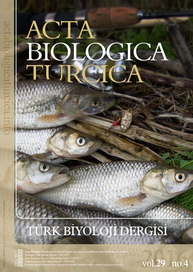An oasis in the Central Anatolian steppe: the ecology of a callopse doline
Abstract
Keywords
Full Text:
PDFReferences
Anica, C.-G. and Mojca, Z. 2010. The Impact of human activities on dolines (sinkholes) – Typical geomorphologic features on karst (Slovenia) and possibilities of their preservation. Geographica Pannonica, 14, 109–117.
Antonic, O., Kusan, A. and Hrasovnc, B. 1994. Microclimatic and topoclimatic differences between the phytocoenoses in the Viljska Ponikva Sinkhole, Mt. Risnjak, Croatia. Hrwatski meteoroloiki dasopis, 32, 37–49.
Armengol, X. and Miracle, M.R. 1999. Zooplankton communities in doline lakes and pools, in relation to some bathymetric parameters and physical and chemical variables. Journal of Plankton Research, 21, 2245–2261.
Aydın, S., Şimşek, M., Çetinkaya, G. and Öztürk, M.Z. 2019. Regime Characteristics of Turkey’s Climatic Regions Determined Using the Erinç Precipitation Efficiency Index. In: 1st Istanbul International Geography Congress Proceedings Book. İstanbul, 752–760.
Bárány-Kevei, I. 1998. Connection between morphology and ecological factors of karst dolines (Aggtelek hills, Hungary). Geografia Fisica e Dinamica Quaternaria, 3, 115–119.
Bárány-Kevei, I. 1999. Microclimate of karstic dolines. Acta Climatologica, 32–33, 19–27.
Bárány-Kevei, I. 2011. Changes in the vegetation of dolines in Aggtelek and Bükk Mountains. Acta Climatologica et Chorologica, 44–45, 25–30.
Bátori, Z., Csiky, J., Farkas, T., Vojtkó, A.E., Erdos, L., Kovács, D., Wirth, T., Körmöczi, L. and Vojtkó, A. 2014a. The conservation value of karst dolines for vascular plants in woodland habitats of Hungary: Refugia and climate change. International Journal of Speleology, 43, 15–26.
Bátori, Z., Farkas, T., Erdős, L., Tölgyesi, C., Körmöczi, L. and Vojtkó, A. 2014b. A comparison of the vegetation of forested and non-forested solution dolines in Hungary: A preliminary study. Biologia (Poland), 69, 1339–1348.
Bátori, Z., Gallé, R., Erdos, L. and Körmöczi, L. 2011. Ecological conditions, flora and vegetation of a large doline in the Mecsek mountains (South Hungary). Acta Botanica Croatica, 70, 147–155.
Batori, Z., Koermoeczi, L., Erdoes, L., Zalatnai, M. and Csiky, J. 2012. Importance of karst sinkholes in preserving relict, mountain, andwet-woodland plant species undersub-Mediterranean climate: a case study from southern Hungary. Journal of Cave and Karst Studies, 74, 127–134.
Bátori, Z., Vojtkó, A., Maák, I.E., Lőrinczi, G., Farkas, T., Kántor, N., Tanács, E., Kiss, P.J., Juhász, O., Módra, G., Tölgyesi, C., Erdős, L., Aguilon, D.J. and Keppel, G. 2019. Karst dolines provide diverse microhabitats for different functional groups in multiple phyla. Scientific Reports, 9.
Bennie, J., Huntley, B., Wiltshire, A., Hill, M.O. and Baxter, R. 2008. Slope, aspect and climate: Spatially explicit and implicit models of topographic microclimate in chalk grassland. Ecological Modelling, 216, 47–59.
Brullo, S. and del Galdo, G.G. 2001. Astracantha dolinicola (Fabaceae): A new species from Crete. Nordic Journal of Botany, 21, 475–480.
Davis, P.H. 1965. Flora of Turkey.
Davis, P.H. 1988. Flora of Turkey and the East Aegean Islands. Edinburgh University Press
Egli, B., Gerstberger, P., Greuter, W. and Risse, H. 1990. Horstrissea doinicola , a new genus and species of umbels ( Umbelliferae , Apiaceae ) from Kriti ( Greece ). Willdenowia, 389–399.
Faivre, S. and Pahernik, M. 2007. Structural influences on the spatial distribution of dolines, Island of Brač, Croatia. Zeitschrift für Geomorphologie, 51, 487–503.
Favretto, D. and Poldini, L. 1985. The vegetation in the dolinas of the karst region near Trieste (Italy). Studia. Geobotanica., 5, 5–18.
Ford, D. and Williams, P. 2007. Karst Hydrogeology and Geomorphology. West Sussex, England, John Wiley & Sons Ltd,.
Herault, B. and Thoen, D. 2009. How habitat area, local and regional factors shape plant assemblages in isolated closed depressions. Acta Oecologica, 35, 385–392.
Horvat, I. 1953. Vegetacija ponikava. Hrvatski Geografski Glasnik, 14–15, 1–25.
Iijima, Y. and Shinoda, M. 2000. Seasonal changes in the cold-air pool formation in a subalpine hollow, central Japan. International Journal of Climatology, 20, 1471–1483.
Nazik, L., Poyraz, M. and Karabıyıkoğlu, M. 2019. Karstic Landscapes and Landforms in Turkey. In: C. Kuzucuoğlu, A. Çiner and N. Kazancı (Editors) Landscapes and Landforms of Turkey . Springer, Cham, 181–196.
Ozkan, K., Gulsoy, S., Mert, A., Ozturk, M. and Muys, B. 2010. Plant distribution-altitude and landform relationships in karstic sinkholes of Mediterranean region of Turkey. Journal of Environmental Biology, 31, 51–60.
Öztürk, M.Z., Çetinkaya, G. and Aydın, S. 2017. Köppen-Geiger İklim Sınıflandırmasına Göre Türkiye’nin İklim Tipleri. Coğrafya Dergisi / Journal of Geography, 17–27.
Öztürk, M.Z., Şener, M.F., Şener, M. and Şimşek, M. 2018a. Structural controls on distribution of dolines on Mount Anamas (Taurus Mountains, Turkey). Geomorphology, 317, 107–116.
Öztürk, M.Z., Şimşek, M., Şener, M.F. and Utlu, M. 2018b. GIS based analysis of doline density on Taurus Mountains, Turkey. Environmental Earth Sciences, 77, 536.
Öztürk, M.Z., Şimşek, M. and Utlu, M. 2015. Tahtalı Dağları (Orta Toroslar) karst platosu üzerinde dolin ve uvala gelişiminin CBS tabanlı analizi. Türk Coğrafya Dergisi, 65, 59–68.
Raschmanová, N., Miklisová, D. and Kováč, L. 2013. Soil Collembola communities along a steep microclimatic gradient in the collapse doline of the Silická l’adnica Cave, Slovak Karst (Slovakia). Biologia, 68, 470–478.
Raschmanová, N., Miklisová, D. and Kováč, Ľ. 2018. A unique small-scale microclimatic gradient in a temperate karst harbours exceptionally high diversity of soil Collembola. International Journal of Speleology, 47, 247–262.
Smith, A.J.E. (Anthony J.E. 2004. The moss flora of Britain and Ireland. Cambridge University Press, 1012pp.
Steinacker, R., Whiteman, C.., Dorninger, M., Pospichal, B., Eisenbach, S., Holzer, A.., Weihs, P. and Mursch-Radlgruber, E, Baumann, K. 2007. A Sinkhole Field Experiment in the Eastern Alps. Bulletin of the American Meteorological Society, 88, 701–716.
Vilović, T., Buzjak, S. and Buzjak, N. 2019. Floristic and microclimatic features of the Sovljak doline (Mt. Velika Kapela, Croatia). Sumarski List, 143, 35–43.
Whiteman, C.D., Haiden, T., Pospichal, B., Eisenbach, S. and Steinacker, R. 2004. Minimum temperatures, diurnal temperature ranges, and temperature inversions in limestone sinkholes of different sizes and shapes. Journal of Applied Meteorology, 43, 1224–1236.
Refbacks
- There are currently no refbacks.

